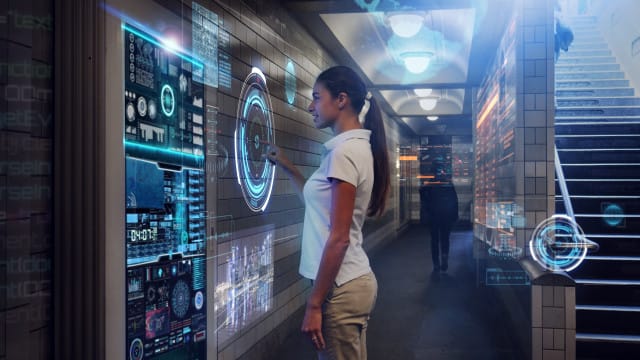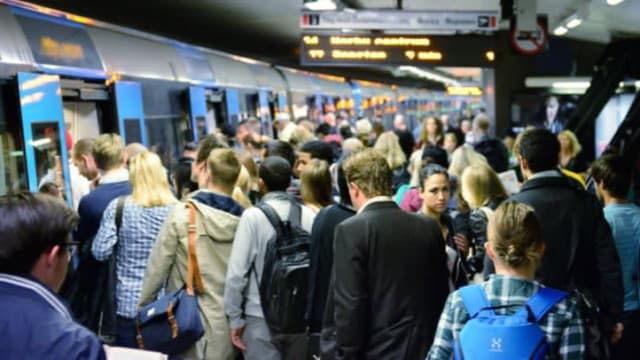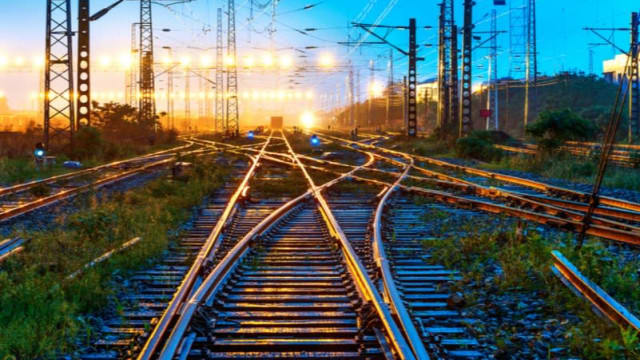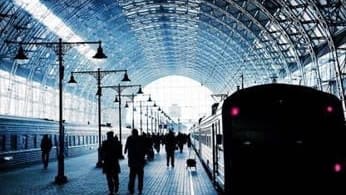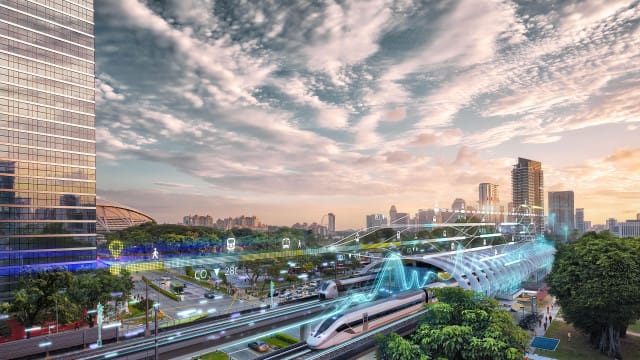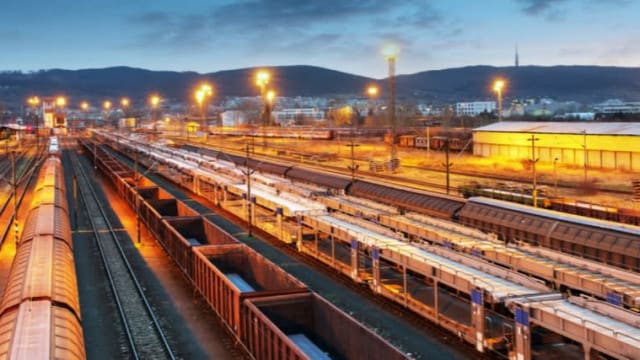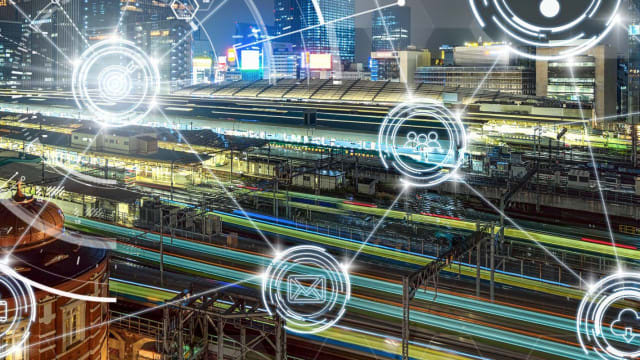Events
Upcoming
Past
Paving the way to FRMCS
Several railway operators are on the way to digitalization and automation of their railway operations, they are already running special programs, such as Smart Rail 4.0, Digitale Schiene, DigiRail, etc. These programs allow future services to run even more reliably, increase capacity on the existing rail networks, improve safety for employees and optimize system costs. FRMCS, enabled by the latest mobile communication technology – 5G – plays a central role by not only replacing the legacy GSM-R communication system, but also by allowing the implementation of a broad range of new use cases, such as ATO, IoT and remote operation.
Nevertheless, the introduction path will be phased. Coexistence and extended lifecycle of current generation systems will run for quite a few years on a parallel track. FRMCS technology will be tested and gradually deployed throughout the network and rolling stock fleet until GSM-R switches off.
The future of passenger rail
We consider the future of passenger rail in the 2020s. There can be little doubt that the coronavirus pandemic has shaken faith in public transport, but rail remains fundamentally attractive for its ability to move people efficiently with minimal land take and an extremely low carbon footprint. This discussion will assess the outlook for passenger operators and how they might adjust to a ‘new normal’.
Developing smart rail infrastructure
We examine the challenges facing infrastructure managers and the opportunities for technological innovations to reduce the cost and improve the efficiency of railway construction and maintenance.
Efficient rail solutions for a sustainable future
Find out how to save money through innovative, safe and sustainable rail operations.
Join 3M and industry experts to learn how to drive cost savings through sustainable solutions for enhanced passenger experience, increased safety, reduced downtime and simplified cleaning of rail cars.
The measure of success in rail transport is no longer solely defined by a fast and reliable service. It now requires excellence throughout the total passenger and worker experience, including comfort, safety, cleanliness and the visual appeal that attracts customers to come on board… and keeps them coming back.
Urban Track Design: Avoiding familiar pitfalls
Pandrol works collaboratively with customers to create a safer future for rail infrastructure, supplying innovative solutions, market-leading products and advice designed to maximise efficiencies, safety and uptime around the world. Sharing their experience from delivering solutions for urban transits across the world, the discussion will showcase potential solutions to the common challenges faced by track operators, installers and designers.
Sustainable, seamless and safe mobility for more liveable cities
- In action
In this session we combine three individual case studies and look at best practice examples with an impact on urban mobility. We discuss how MaaS platforms for intermodal mobility can help build urban transportation networks. We reassess safe urban travel by looking at how existing and future technology can help ensure clean air in trains. And we also explore light rail in an urban context. Along these examples, we seek to understand: Which lessons cities and transportation systems can learn from each other, in order to make transport in cities safer, more sustainable and seamless.
Sustainable, seamless and safe mobility for more liveable cities
As more and more of the world's population moves into cities, a major challenge is to create integrated mobility systems - with rail solutions at their core - that make transport from door to door seamless, safe and sustainable. In this session we discuss how we can create or shape cities where people really wish to live. Cities in which jobs, shops, entertainment and green zones are easy to access via multimodal means of transportation. And in a dialogue with industry experts, we also explore how to increase the COVID-19 resilience of transportation in cities.
Innovation in rail freight
Assessing the outlook for global rail freight in the 2020s. With its profile having been lifted by the coronavirus pandemic, rail freight plays a key role in maintaining global logistics chains. But freight applications differ markedly across the world, from heavy commodity traffic in Russia and North America to an increasing focus on intermodal operations in Europe. In this session, our diverse panel of specialists will examine the key trends.
Keys to Commercial Success in Covid-19 Recovery
The session will cover the keys to commercial success as the rail sector prepares for a ‘new normal’. We will consider fundamental changes brought by the ongoing crisis, including profound shifts to how rail commercial teams function; changing customer expectations and how commercial teams can most effectively accommodate those new expectations; and where commercial teams should prioritize new investments. We will also discuss how technology can accelerate recovery, and how rail operators can drive value during a gradual return to pre-crisis travel patterns.
Rail after Covid-19
In the first session of our Rail Broadcast Week, we will seek to assess the impact of the coronavirus pandemic on the global rail sector. We will examine how far the ongoing crisis could lead to fundamental changes to the way transport networks function, how they are funded and what their role is. We will also consider whether rail operators should expect a gradual return to pre-crisis travel patterns, or whether the sector must prepare for a ‘new normal’.
Critical Communications Solutions for Transport
Communications technology has become the backbone of modern railway operations, as more and more systems exchange data between track and train.
As well as conventional voice communication between the controllers and drivers or passengers, data links are needed to support condition monitoring and fault diagnostics, CCTV and security alarms, and a growing range of other digital systems.
Meanwhile, communications-based train control systems and increased automation require secure channels for exchanging vital and mission-critical data.
Intelligent Infrastructure: Delivering Asset Efficiencies for the UK’s High Speed Network
This ABB Best Practice series will assess how technologies in traction energy supply can enhance the efficiency of a high speed railway. As a case study, the discussion will showcase the innovations that UK Power Network Services will deliver to support the operation of the High Speed 1 link between London and the Channel Tunnel, to deliver a future proof, smarter and more insightful operation.
The IoT-enabled railway
Digitisation of main line and urban railways is gathering pace as policymakers push operators and infrastructure managers to enhance the capacity and efficiency of their networks.
From smarter and safer stations to predictive maintenance of infrastructure and rolling stock, the modern railway has the potential to transform its operations by embracing IoT sensors, machine learning and AI-driven analytics. Yet realising the potential of such technology in a live railway environment remains a challenge.



Securing a digital railway
Digitisation of main line and urban railways is gathering pace as policymakers push operators and infrastructure managers to enhance the capacity and efficiency of their networks. But with the widespread adoption of networked tools comes an increasing need to mitigate the risks posed by cyber threats.



Secure data for critical rail assets
As modern railways adopt digital technology to increase asset reliability, improve on-time performance and reduce risk by using sensors on geographically dispersed equipment, rail infrastructures and signaling systems will become ever more exposed to cyber-attacks. This webcast will share cross-industry experience in creating a robust security solution for critical infrastructure data monitoring and management.
In this presentation followed by a Q&A session organised by OSIsoft and hosted by Railway Gazette TV, a panel of high-level speakers will address key issues surrounding secure data infrastructure.




ABB presents: Future Trends in Rail Technology
Automation, digitisation and energy efficiency are among the megatrends which are acting as a catalyst for radical change across the rail and urban mobility sector. Enterprise software specialist ABB considers how the rail sector might best harness these trends to enable the sector to make the most of a technological revolution.
Connecting Data & People
The data revolution is driving collaboration, knowledge and productivity, ultimately impacting the way railways could be managed and how decisions are made.
But people remain at the heart of the business, and the advent of new tools and systems has a major impact on management, staff and customers at all levels. The rail industry must ensure they adopt the right mix of skills, tools and digital strategies, to deliver performance benefits and value.
The Cybersecure Railway
Digitisation of main line and urban railways is gathering pace as policymakers push operators and infrastructure managers to enhance the capacity and efficiency of their networks. But with the widespread adoption of networked tools comes an increasing need to mitigate the risks posed by cyber threats.




The Convergent Railway
Data analytics and real-time feedback from rolling stock and wayside assets mean that operational systems and IT infrastructure are converging, raising the prospect of more efficient and responsive rail operations.
An error occurred trying to play the stream. Please reload the page and try again.
Close
